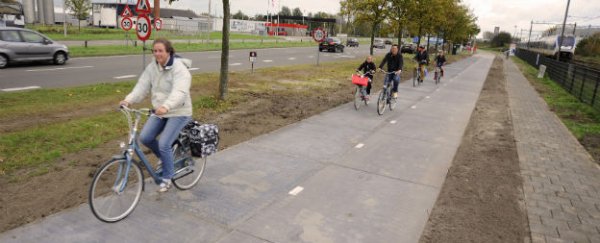A bike path that services 2,000 cyclists per day as they travel between the suburbs of Krommenie and Wormerveer in Amsterdam is now dotted with solar panels. Set to open next week, the 70-metre path is the first solar road in the world - a proof of concept that engineers around the world are eager to copy.
The path, which the local government plans to extend to 100 metres in 2016, cost €3m (AUD$4.3m) to build, says Philip Oltermann from The Guardian. Named the SolaRoad, it was made using rows of crystalline silicon solar cells, which were embedded into the concrete of the path and covered over by a thick, tempered glass. The surface of the road has been treated with a special non-adhesive coating, and the road itself was built to sit at a slight tilt in an effort to keep dust and dirt from accumulating and obscuring the solar cells.
While the amount of solar energy generated from the road will be pretty modest - once stretched to 100 metres, it's expected to produce enough energy to power three households - the point of the project is to show that solar roads can actually be practical.
The team behind the bike path, Netherlands' TNO Research Institute, is now looking into extending the technology to some of the country's 140,000 km of public road. Having already performed tests on how much weight - say, a tractor and a semitrailer - these embedded solar cells can withstand, engineer Sten de Wit from the institute told Oltermann that up to 20 percent of the Netherlands' roads would be suitable for a solar upgrade.
While the Netherlands has been the fastest country to embrace the technology of solar roads, scattered projects around the world are following suit - most notably a couple of American engineers, Julie and Scott Brusaw, who earlier this year replaced their parking lot with solar panels. The pair, whose company Solar Roadways has received millions in funding from the US Federal Highway Administration, are now working on getting their designs out to the country's public roads.
"If all the roads in the US were converted to solar roadways, the Solar Roadways website claims, the country would generate three times as much energy as it currently uses and cut greenhouse gases by 75 percent," says Oltermann at The Guardian.
Look at the ridiculous video the Brusaws made:
Source: The Guardian
